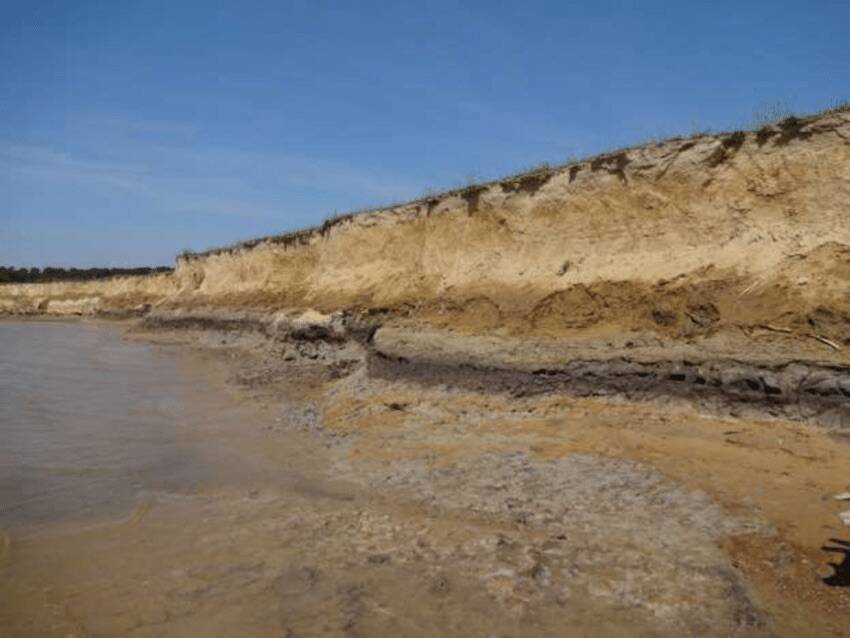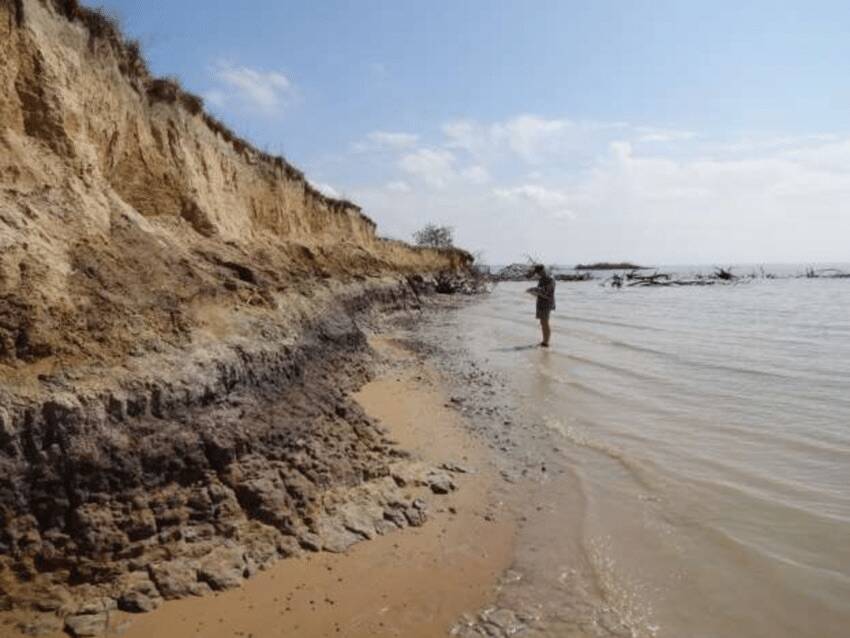Geologist Darrin Lowery published his findings from Parsons Island in a 260-page manuscript online, which has drawn criticism from academics who would have preferred Lowery publish in a peer-reviewed journal.

Darrin LoweryThe eroding shoreline of Parsons Island is revealing thousands of years of hidden human history.
For years, scientists have hotly debated when, exactly, humans first arrived in the Americas. But now, a scientist affiliated with the Smithsonian Institution believes he has uncovered evidence in Maryland that could set the record straight, once and for all.
Darrin Lowery, a coastal geologist, has made 93 scientific visits to Parsons Island in the Chesapeake Bay, where he and his team have uncovered 286 artifacts from the earliest days of humanity’s settlement in North America. The oldest of these items was embedded in charcoal that dates back 22,000 years — 7,000 years earlier than humans were previously thought to have been in America.
Lowery’s research was backed up by similar finds in New Mexico’s White Sands National Park, which seemed to insinuate human settlement between 21,000 and 23,000 years ago. And if Lowery’s findings are accurate, these discoveries could rewrite American prehistory as we know it.
Artifacts From Parsons Island Point To Early Human Inhabitants
As The Baltimore Sun reports, modern scientists mostly agree that humans inhabited the Americas as early as 15,000 years ago. But over the course of the past decade, Lowery and a group of cohorts have made frequent trips to Maryland’s Parsons Island, which is rapidly eroding as sea levels rise.
This rapid erosion means researchers have limited time to find artifacts on the island, but it’s also part of the reason researchers are so fascinated with the area in the first place.
Archaeologist Sebastien Lacombe, who visited Parsons Island in 2017, offered this explanation.
“The visit reinforced my will to invest my time into this time period, because it’s a very fragile record,” he said. “It’s at risk of disappearing, and we’re at risk of [allowing] these sites and artifacts to lose their meaning forever.”

Darrin LoweryA comparison of Clovis and pre-Clovis artifacts.
For Lowery, the shorelines of the Chesapeake Bay have been a fascination since childhood. At the age of nine, he found what he believes was a Clovis point — an artifact that was at the time believed to have come from the first Americans — in his backyard on Tilghman Island.
He would, of course, go on to become a geologist; and this field of study brought him to Parsons Island.
In 2010, Lowery published an article in Quaternary Science Reviews in which he described layers of windblown silt deposited at Maryland’s Miles Point between 13,000 and 41,000 years ago — but Lowery lamented the “unconformity” of the sediment layers. Thousands of years of history, he said, were missing.
That’s when Lowery discovered a black streak of sediment coming from Parsons Island, which he believed could fill in those missing years. With the permission of the Corckran family, who owns the 78-acre Parsons Island, Lowery began his research, hoping to unveil a complete geological timeline from Parsons Island’s sediment.
Then, in 2013, he made an even more stunning discovery. Embedded in a crumbling wall, Lowery and his team found a leaf-shaped prehistoric stone tool. After dating the surrounding sediment, they realized that it was more than 20,000 years old.

Darrin LoweryIn-situ bifate found in the sediment layer.
Over the next 10 years, Lowery and his team would make more than 90 trips back to the island, collecting 286 artifacts in total from the coastline.
Of course, 20,000 years ago, this area wasn’t a coastline at all. Much of the region would have been covered in a sheet of ice, with the tools themselves likely dating back to the “last glacial maximum,” the most recent of the five ice ages.
“This was a swale, where water was collecting,” Lowery said, picturing the prehistoric landscape. “You’ve got a dune. It’s got sedges and small trees on it that are windblown and all contorted, and then behind it you’ve got a little pond.”
The pond, he believes, would likely have attracted animals such as bison, musk oxen, and llamas — and the presence of their fossilized molars along the shore seems to provide evidence for this. And where there were animals to be hunted, humans were likely to follow.

Darrin LoweryFellow researcher Dr. John Wah examining the eroding shoreline.
Parsons Island isn’t the only “pre-Clovis” site to have been discovered in recent years, but most others have faced their own forms of controversy. Meadowcroft Rockshelter in Pennsylvania, for example, was excavated by archaeologist James Adovasio in 1973 and dates back 16,000 years. At the time, however, others in the field cast significant doubt on the find, and it is still heavily criticized today.
Another archaeologist, Tom Dillehay, said part of the issue stems from the “Clovis police,” a group of scientific gatekeepers who seem to reject any pre-Clovis sites, with or without good reason. That only started to change in 1997 with a site in Chile called Monte Verde, when a group of respected archaeologists declared it authentic. Dillehay, however, had begun working at the Monte Verde site decades earlier.
“It took about 25 to 30 years for Monte Verde to be accepted,” Dillehay said. “We went through hell.”
Now, Lowery’s discoveries at Parsons Island are facing their own controversy and criticism — largely because Lowery did not have his findings peer-reviewed.
The Controversy Surrounding Darrin Lowery’s Discoveries
Whereas archaeological and geological research similar to that being conducted at Parsons Island would normally be published in an academic journal after thorough review from scientific peers, Lowery presented the results of his study in a 260-page manuscript published online.
This move alone has garnered criticism from some in the scientific community, who refuse to accept the findings as currently presented.
Lowery, for his part, seems to think that going through the peer-review process would simply allow other scientists to dismiss evidence that doesn’t support the leading paradigm. He also said that “life’s too short” to go about formally publishing the study, saying this particular component of academic science is “the dumbest game I’ve ever played.”
Lowery isn’t alone in his belief. Stuart Fiedel, an independent archaeologist in western Massachusetts, told The Baltimore Sun, “There are people I know in the field who will not pay any attention to [Lowery’s research], because it has not been peer-reviewed, which I think is kind of sticking your head in the sand… It’s there. We can’t act as [if] nothing’s been found there.”

Darrin LoweryMiocene-age gompthere teeth found at Parsons Island.
David Meltzer, an archaeologist at Southern Methodist University, falls squarely in the other camp, saying he will not discuss Lowery’s claims “until they go through the wringer of peer review and get published.”
Then there’s the issue of the site’s rapid erosion, which brings its own complications. Many of the artifacts Lowery found were only collected after they’d fallen out of the bluff, which obscures their place in the geological timeline. Nine objects were found in situ, but even then only three could be dated using charcoal found nearby.
None of these are quite the smoking gun that would satisfy skeptics. Still, Lowery is determined to keep excavating the area, which he views as his “swan song.” Perhaps he will find the rock-solid evidence he needs to convince his critics.
Or perhaps, as fellow researcher James Feathers, who dated samples from Parsons Island, said: “Sometimes you have to wait for people to die off” and for old prejudices to fade to make way for new ideas.
After reading about Darrin Lowery’s controversial discoveries at Parsons Island, learn the answer to the question “How old is America?” Or, learn about castoroides, the giant beavers that roamed the world during the Ice Age.





